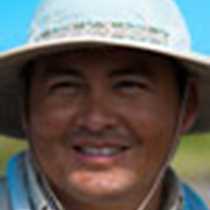Today the National Geographic Islander was anchored in a calm bay at Santiago Island. The central islands in the Galapagos have a different ecosystem with lush greenery and warmer water. The warm waters are a perfect home for a mosaic of fish.
The day started with an early outing on Espumilla beach. Eager to explore the island was the most famous naturalist in the world, “Charles Darwin”, who spent nine days collecting specimens that led him to the development of the theory of evolution through natural selection. Unfortunately, due to the sea conditions on the landing beach we couldn’t disembark on the island, but we were able to improvise a Zodiac ride along the coastline. Our explorers were fascinated by the native brown pelicans and blue-footed boobies perched on the basaltic coastline. Kayaking was a great alternative to approach the huge cliffs of Buccaneer Cove. Kayakers spotted swallow tailed gulls, brown pelicans, and noddies among other migratory birds.
After breakfast we explored the island with other options offered by our expedition leader. Snorkeling was a significant activity today. The visibility was fantastic! Stingrays, white-tipped sharks, Galapagos fur seals, sea lions and a great variety of colorful fish delighted our guests in the water.
In the afternoon we landed on James Bay on a black sand beach. This place, also known by Galapageños as Puerto Egas, was a salt mining town in the early fifties. The black sand beach with sea lions and marine iguanas offered a nice, comfy environment. To explore the island in more in detail we took the path that led us along the coastline, which offered us sightings of Sally light foot crabs, birds, iguanas and sea lions.
After seeing so much life in the tidal pools, our hike ended in a place where old collapsed lava flows full of ocean water provide a unique environment for Galapagos fur seal colonies. As the sun set behind the shield volcanoes of Isabela, we sat and devoted a minute of silence for those species that not longer are present in the Galapagos Islands and also to appreciate all of the creatures we were able to encounter on our adventures today.







